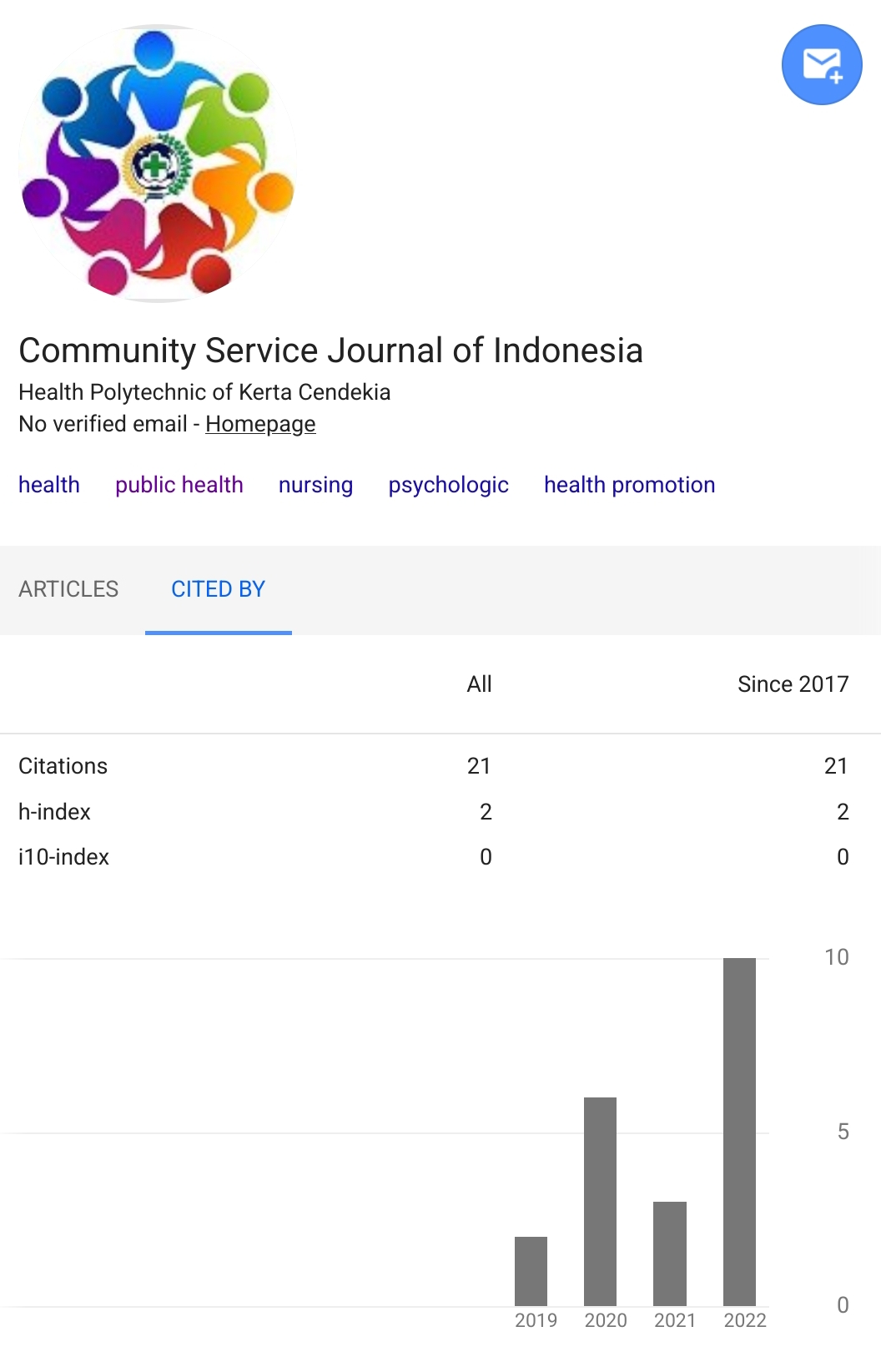EMPOWERING PREGNANT MOTHERS TO INCREASE SELF CARE AS AN EFFORT TO PREVENT PREECLAMSIA
Abstrak
Maternal Mortality Rate (MMR) is one indicator to see the success of maternal health efforts. One of the causes of AKI is preeclampsia which is the main cause of maternal and perinatal morbidity and mortality worldwide, including in Indonesia. According to the World Health Organization (WHO), one of the causes of maternal and fetal morbidity and mortality is severe preeclampsia, the incidence ranges from 0.15%-38.4%. In developed countries the incidence of severe pre-eclampsia ranges from 6-7% and eclampsia 0.1-0.7%. The incidence of pre-eclampsia in Indonesia ranges from 3-10% of all pregnancies. The maternal mortality rate in Indonesia is mostly caused by bleeding as many as 1,330 cases, hypertension in pregnancy as many as 1,110 cases, and circulatory system disorders as many as 230 cases. Therefore, it is necessary for nurses to play a role in overcoming preeclampsia, one of which is being an educator to help pregnant women reduce the risk factors for preeclampsia. The purpose of this activity is to increase the knowledge and skills of pregnant women in carrying out care during pregnancy so that they can prevent the occurrence of preeclampsia during pregnancy. The method used in this community service activity is to conduct health education about efforts to prevent preeclampsia during pregnancy at BKIA Islamic Hospital Surabaya. This activity was carried out for three months. Knowledge and skills of pregnant women in performing self-care to prevent preeclampsia were evaluated by questionnaire. The results of community service show that pregnant women have better knowledge of self-care to prevent preeclampsia.Referensi
Angsar, MD. (2009). Ilmu Kebidanan, Yayasan Bina Pustaka Sarwono Prawirohardjo, Jakarta: EGC.
Alkema, L., Chou, D., Hogan, D., Zhang, S., Moller, A. B., Gemmill, A., … Say, L. (2016). Global, regional, and national levels and trends in maternal mortality between 1990 and 2015, with scenario-based projections to 2030: A systematic analysis by the un Maternal Mortality Estimation Inter-Agency Group. The Lancet. https://doi.org/10.1016/S0140-6736(15)00838-7
Arikah, T., Rahardjo, T. B. W., & Widodo, S. (2020). Faktor Risiko Kejadian Hipertensi pada Ibu Hamil di Puskesmas Kramat Jati Jakarta Timur Tahun 2019. Jurnal Penelitian
Bardja, S. (2020). Faktor Risiko Kejadian Preeklampsia Berat / Eklampsia pada Ibu Hamil Risk Factor for The Occurrence of Severe Preeclampsia / Eclampsia in Pregnant Woman. Jurnal Kebidanan, 12(January), 18–30
Doengoes. M. E, Et. Editor Monica, E. (2010). Nursing Care Plans Guidelines for Planning and Documenting Patient Care, Edisi 3. Alih Bahasa: Kariasa IM. Jakarta: EGC.
Ekawati, E., Setyowati, S., & Budiati, T. (2019). “Sehati” health education to improve physical and psychological adaptation of the postpartum women having pre-eclampsia. Enfermeria Clinic https://doi.org/10.1016/j.enfcli.2019.04.0 54.
Ekasari, T., Natalia, M. S. and Zakiyyah, M. (2019). Faktor–Faktor Yang Mempengaruhi Kejadian Preeklampsia Dikabupaten Probolinggo’, JI-KES (Jurnal Ilmu Kesehatan). doi: 10.33006/ji-kes.v2i2.119.
Johan & Sunarsih (2012). Hubungan Antara Preeklampsia Dengan Kejadian BBLR Dan Asfiksia Neonatorum Di VK IRD RSUD Dr Soetomo Surabaya’, Kesehatan 8. https://doi.org/10.24990/injec.v2i1.21
Katmini, K., Nurcahyanti, F. D., & Yunita, A. (2019). The Association Between Health Belief Model Theory and Preeclampsia on Pregnant Women in Kediri Regency East Java. Journal of Health. https://doi.org/10.30590/vol6-no1-p1-5.
Komalasari, T. and Rahayu, S. (2017). Hubungan Riwayat Hipertensi, Diabetes Melitus, dan Kehamilan Ganda dengan Kejadian Preeklampsi pada Ibu Hamil Di Rumah Sakit Umum Sumedang’, Jurnal Pendidikan dan Pelayanan Kebidanan Indonesia. doi: 10.24198/ijemc.v2i3.24.
Manuaba, I. (2010). Memahami Kesehatan Reproduksi Wanita’, Jakarta: Arcan. https://doi.org/10.31596/jpk.v2i1.28.
Manuaba, I. A. C., Manuaba, I. B. G. F. and Ida (2012). Anatomi dan Fisiologi Alat Reproduksi’, in Ilmu Kebidanan Penyakit Kandungan dan KB.
##submission.copyrightStatement##
##submission.license.cc.by-nc4.footer##Authors who publish with Community Service Journal of Indonesia agree to the following terms:
- Authors retain copyright licensed under a Creative Commons Attribution-NonCommercial 4.0 (CC BY-NC 4.0), which allows others to remix, tweak, and build upon the authors' work non-commercially, and although the others' new works must also acknowledge the authors and be non-commercial, they don't have to license their derivative works on the same terms.
- Authors are permitted and encouraged to post their work online (e.g., in institutional repositories or on their website) prior to and during the submission process, as it can lead to productive exchanges, as well as earlier and greater citation of published work (See The Effect of Open Access). Authors can archive pre-print and post-print or publisher's version/PDF.














